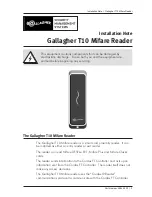
Chapter 4
Signal Connections
4-4
www.natinst.com
PFI0/TRIG1
DGND
Input
Output
PFI0/Trigger 1—As an input, this is one of the
Programmable Function Inputs (PFIs). PFI signals are
explained in the
section later in this
chapter.
As an output, this is the TRIG1 (AI Start Trigger) signal. In
posttrigger data acquisition sequences, a low-to-high
transition indicates the initiation of the acquisition
sequence. In pretrigger applications, a low-to-high
transition indicates the initiation of the pretrigger
conversions.
PFI1/TRIG2
DGND
Input
Output
PFI1/Trigger 2—As an input, this is one of the PFIs.
As an output, this is the TRIG2 (AI Stop Trigger) signal. In
pretrigger applications, a low-to-high transition indicates
the initiation of the posttrigger conversions. TRIG2 is not
used in posttrigger applications.
PFI2/CONVERT*
DGND
Input
Output
PFI2/Convert—As an input, this is one of the PFIs.
As an output, this is the CONVERT* (AI Convert) signal. A
high-to-low edge on CONVERT* indicates that an A/D
conversion is occurring.
PFI3/GPCTR1_SOURCE
DGND
Input
Output
PFI3/Counter 1 Source—As an input, this is one of the PFIs.
As an output, this is the GPCTR1_SOURCE signal. This
signal reflects the actual source connected to the
general-purpose counter 1.
PFI4/GPCTR1_GATE
DGND
Input
Output
PFI4/Counter 1 Gate—As an input, this is one of the PFIs.
As an output, this is the GPCTR1_GATE signal. This signal
reflects the actual gate signal connected to the
general-purpose counter 1.
GPCTR1_OUT
DGND
Output
Counter 1 Output—This output is from the general-purpose
counter 1 output.
PFI5/UPDATE*
DGND
Input
Output
PFI5/Update—As an input, this is one of the PFIs.
As an output, this is the UPDATE* (AO Update) signal. A
high-to-low edge on UPDATE* indicates that the analog
output primary group is being updated for the 6035E.
Table 4-1.
I/O Connector Signal Descriptions (Continued)
Signal Name
Reference
Direction
Description
















































